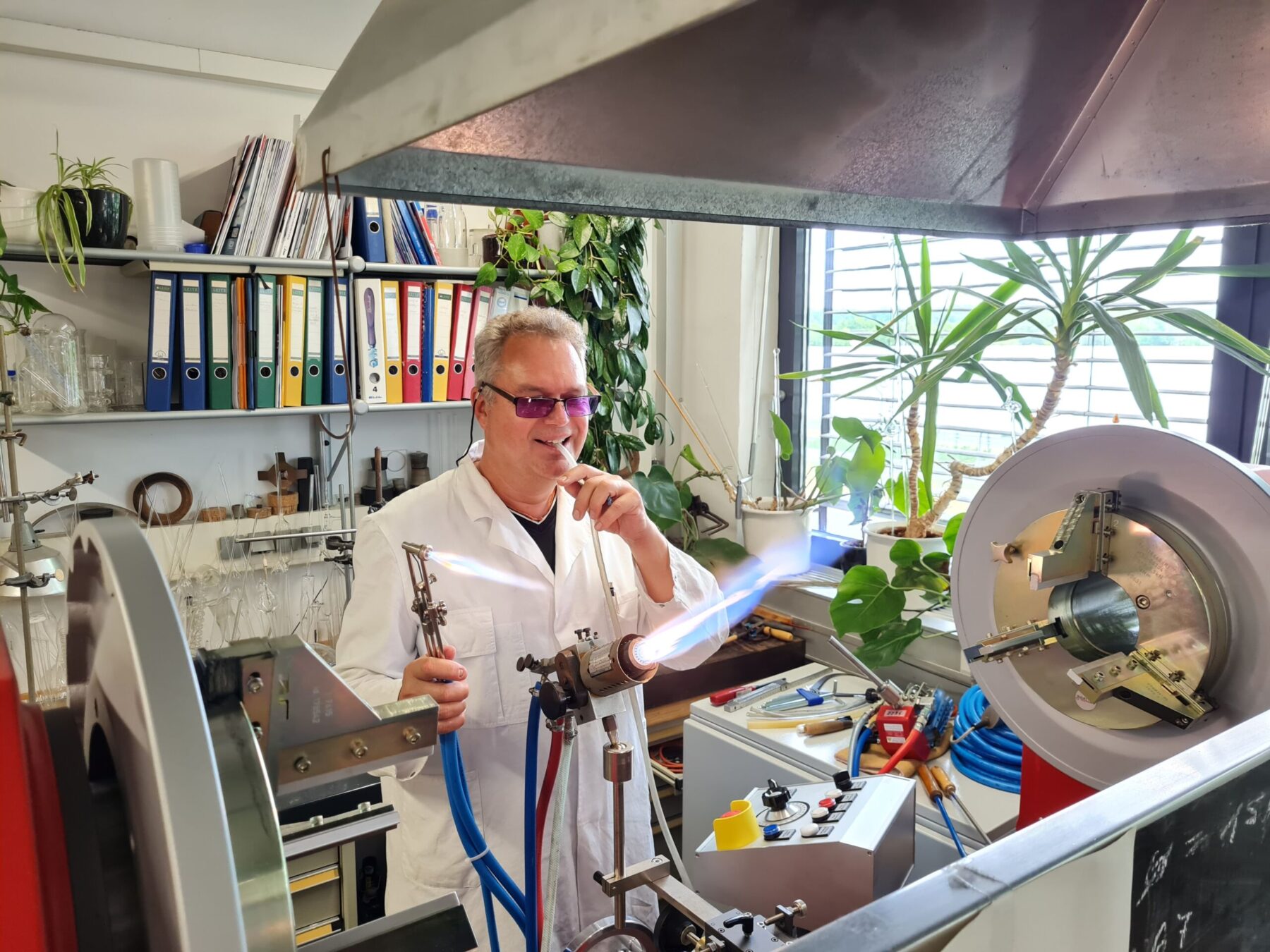
Unusual Jobs at the Potsdam Science Park – Meet Cliff Janiszewski, a Scientific Glassblower
As a material for use in science, glass has many advantages. As well as being resistant to heat, cold and most acids, it is also fireproof, easy to clean and transparent. These qualities make it absolutely essential in science, particularly for lab work where glass flasks and cylinders are indispensable. In teaching and research, glass equipment needs to be constantly reused, adapted and repaired. This is where Cliff Janiszewski comes in, as a glass apparatus maker at the Max Planck Institute of Colloids and Interfaces – one of the more unusual professions at Potsdam Science Park.
Cliff Janiszewski turns up the glass blower flame while adjusting the supply of oxygen, natural gas and compressed air. Behind the powerful flame jet, small sparks start to appear and the glass bulb begins to glow. The glass has now reached a temperature of about 820 to 1000° C and has the consistency of liquid honey. With the glass now at the right working temperature, Cliff takes the glass out of the flame, places the cold end of the tube to his mouth and blows a symmetrical shimmering ball.
When he puts the ball down, you can’t see the material, but it is still very hot. It takes about five minutes for the glass to cool slightly. Cliff says that injuries in this occupation are certainly possible: burns are always a risk when working with fire, and you can also accidentally cut yourself.
From early ambitions in furniture restoration to the discovery of a passion for glass
He has only rarely been injured during the past 23 years, says Cliff: such is the value of experience. For more than two decades Cliff Janiszewski has been working as a glassapparatus maker at the Max Planck Institute of Colloids and Interfaces at Potsdam Science Park. The man himself prefers the term “scientific glass blower”, as it emphasises the artisanal side of his work, in service of science. Originally, Cliff wanted to become a furniture restorer, but the route into that occupation seemed rather long and arduous.
At the time, his parents were working in a television electronics factory, which also employed glass blowers, mainly to manufacture transmitting tubes. Cliff completed a work placement at the factory. Finding that he enjoyed working with glass, he then began an apprenticeship in glass apparatus construction at the glass school in Thuringia, before moving on to what was then known as the Academy of Sciences, Berlin Adlershof. In the years after Germany’s reunification there was little call for glass blowing, which is why Cliff completed a second apprenticeship as a central heating and ventilation engineer. Shortly after that, however, he returned to his original job as a scientific glass apparatus maker – this time at the MaxPlanckInstitute of Colloids and Interfaces (MPIKG) in Potsdam Golm.
Groundwork for research offers a lot of variety
The glazing workshop creates apparatus which is used in scientific research. Janiszewski’s creations are most frequently used in colloid chemistry – for example in nanotechnologies (Prof. Antonietti) or in the field of biomolecular systems (Prof. Seeberger). Janiszewski is often also asked to give advice, as scientists often find it hard to know which types of apparatus can actually be made from glass: “Scientists have a variety of requirements for their working materials: they need a cooling element and various sensors and at the same time they might want to measure something inside the container, introduce gas and occasionally draw out a sample tube. You have to do all that in a piece of glass” Cliff explains.
Most of the time, Cliff receives detailed drawings from individual scientists, illustrating as closely as possible which type of apparatus they want. He points to a sketch that reminds us of a school physics lesson: “This shows a bubble counter. That’s an attachment, this is a double-walled vessel for cooling, then at the side they want another frit”. Frits are filter plates that have a certain permeability and porosity. “Think of it as a coffee filter”. Based on the specifications from the scientists at the Max Planck Institute of Colloids and Interfaces, Cliff then melts the desired glass apparatus from semi-finished compounds such as glass tubing – usually 1.20 m in length with a diameter of between 2 and 120 mm – or from balls or frits.
Highly-specialised glass appliances made with fire, flair and finesse
Every day, at his workshop in Potsdam Science Park, Cliff produces highly specialised glass appliances that MPIKG uses for experiments: these one-off pieces are not otherwise available for purchase. As a raw material, he uses standard blanks from retailers specialising in laboratory glass supplies. The blanks include glass tubes in every possible size and shape, shimmering glass structures, balls and cylinders. The uniform and constant turning of the glass behind the flame demands extensive and lengthy practice. For instance, Cliff recalls that during the first two days of his training, the apprentices were only allowed to practise with a pencil, with no flame in sight. If you went on holiday for three to four weeks, on your return you would have to “get the lightness back in your fingers” during the first few days back at work, he says.
His small glass-blowing workshop is divided into cold working and hot working zones. The work bench is equipped with a zenith burner whose flame heats up to 2000°C and can be selectively shut off. Opposite is a glass turning machine with rotating frames. Cliff says that he has only had this machine for three years, but it lightens the workload considerably as it turns the glass for him, leaving his hands free for other tools. Working with this special material requires a lot of sensitivity: “Glass is fun to work with, but you really have to concentrate, otherwise it won’t work!”, explains Cliff.
99% of the material processed is glass – with a few special exceptions
Cliff particularly appreciates the creativity and variety of his job at MPIKG, and likes the contribution he can make towards fundamental research work. He sometimes produces small series of five to ten pieces, but also creates many one-off items and carries out repairs. Another aspect of his job is cold working, which involves, drilling, slitting, cutting, looping, polishing and engraving. Different pieces of apparatus can be joined together by hot working.
As the structural change, the amount of heat introduced and the altered wall thicknesses cause different tensions in the glass, it has to be relaxed at the end of the process. Borosilicate glass, for example, is heated to the lower transformation point at 530°C, as a result of which the surface does not change, but the tension in the glass does. Cliff has a special device in his workshop that can visually detect the tension in glass. Through the polariscope, purple, green and yellow circles and rings can be seen in glass under tension. It looks pretty, rather like the reflections of sunlight.
In his workshop, Janiszewski processes 99 % borosilicate glass, a special type of laboratory glass which is acid- and alkali resistant. From time to time he also uses the very high-grade quartz glass, and very rarely other materials such as ceramics. Although tools such as diamond grinding or cutting discs are cost-intensive, they are essential in glassworking, since the material is so hard. During his 23 years at the Institute, however, this scientific glassblower has often seen other materials – once even a fossilised mammoth tusk, 1.5 m long. The bone structure had to be examined so it could be artificially imitated in the Biomaterials department. Cliff was one of the few technicians capable of cutting the extremely hard (petrified) mammoth tusk, using the diamond cutting tool. Something he’s rather proud of!

Contact

Karen Esser
PR & Communications
karen.esser@potsdam-sciencepark.de + 49 331 237 351 103